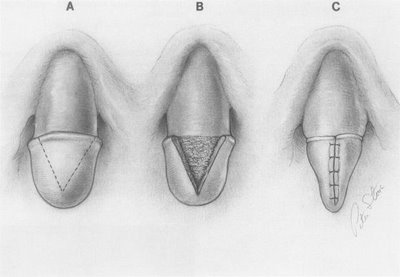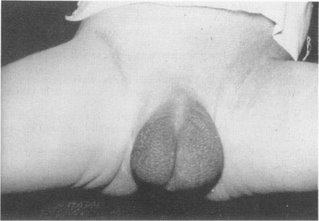For the sake of simplicity, however, for my research project for my Child Development class, I am defining it as those infants born with either aspects of both genitals, or ambiguous genitals, meaning hypospadias (an abnormality of the penis in which the urethra opens on the underside), congenital adrenal hyperplasia (C.A.H.), developmental problems of the external genitalia, virilized females, undervirilzed males, and patients with gonadal tissue of both sexes. Micropenis.

What my paper is really going to deal with, though, are less of the medical ideas, and what the psychological ramifications are. Should children's parents and doctors determine their gender as soon as they're born, which has been the case for decades. Whatever it's "closest" to is what the kid becomes.
 How a micropenis becomes a clitoris.
How a micropenis becomes a clitoris.The problems with this are too in-depth to go into on this here little blog, but the argument rages on. One of the main arguments is, if the parents and doctor don't choose the gender, how do you effectively raise an intersex child? Is that more or less damaging than "choosing" a gender for them, and then have a 50/50 chance of them actually being the opposite gender of what's been chosen for them? There are few things more heartbreaking, the common wisdom says, than a man with a penis not much bigger than a clitoris left to grow up as a man, hoping that the penis will grow as he ages, but then it does not, and he's doomed to go through life as a man without a penis.
The most common of these incidents occurred with a set of twins born in the 50's. During the circumcision process, one of their penises was accidentally cut off (um...) and Bruce thus became Brenda, while retaining all the chromosomal makeup of a man. Though he was raised as a "girl," he was obviously always very masculine, played sports and had numerous temperamental problems, even before puberty. In adolescence the truth about her gender was disclosed and he elected to have surgery to turn back into a man. He eventually got married and had children, but never really adjusted to his new gender, either (it seems that neither really worked for him) and he ended up committing suicide in his early 40's. His suicide was soon followed by his twin who was so distraught at his brother's suicide that he did the same thing. Nature vs. Nurture? Speaks volumes about nature to me. Gender being inherent rather than constructed.

That's just the most famous case. In my research I've started to become a little obssessed with intersex and transgenderism. So much so, in fact, that I've been thinking it might be an area in which I want to specialize as a therapist. Either counseling adults who have suffered traumatic gender issues, or with families who have to make decisions about babies and children. The common theory now being that no surgeries should be done on children until they're old enough to offer consent, and make up their own minds.
Fascinating. Well, at least to me.
4 comments:
Ryan,
It is good that people are taking an interest in this topic. I suggest connecting with the national support group for those with DSD (Disorders of Sex Development). Unfortunately, there was a time when photos were taken of people, and it traumatized them. They were constantly being paraded, poked, and prodded. It hurt them and left them feeling shame over how their body developed. We are always looking to people to promote acceptance and understanding of this often misunderstood diagnosis. Taboo and stigma can take generations to undo. One way you might consider making a difference is to avoid using such pictures. You wouldn't want to be searching about your condition and stumble upon your paraded genitalia, well meaning or not. I love that you used a diagram instead of real surgical photos. I appreciate how you have approached this subject, and hope to hear from you someday. Maybe you will be the one to make a difference for those affected in the future.
I think surgery should be held off until the child is old enough to consent to it. It is the child's body, anyway. Just raise the child first until you can determine which gender they gravitate more towards becoming, then consider surgery after you've discussed it with the child to avoid future psychological harm in adulthood (meaning, be honest and straightforward with the child. Do not hide the child's condition in shame only to have the child find out in adulthood he/she has been lied to all this time. You will cause a lot of anger, mistrust, and emotional trauma to the child, and the child will learn never to trust you or anyone else again). I'm not an expert on this topic by any means, but I've researched it on the Internet quite a bit because I am working on a fictionalized story about a young woman in her late 30's who is intersex and loves having a penis, and I've seen the emotional and psychological damaged caused by people who have had the surgery in infancy only to be told lies and half-truths about it in childhood, then to find out what really happened to them in adulthood, and I find it very heartbreaking to say the least. These people deserve their rights as much as anyone else, including the right to be left alone and not be shamed, hidden, or cut up.
I saw an enlightening documentary about Intersexed people. The interviews included a wide variety of individuals who were born with various types of ambiguous genitalia, hypospadias, and in one person, no genitalia at all. Each of them had suffered many doctors' examinations, multiple surgeries, ashamed parents, and every other kind of suffering imaginable. They all exclaimed that they wish their families had left their bodies alone until they were old enough to make choices for themselves. Parents don't need to explain anything to their little ones until the children ask. When they do ask, the simplest explanation is best.
I am confused by the photo and diagram. The photo seems to show a rather normal penis with the foreskin retracted. The diagram doesn't show an anatomically correct penis (ignoring the lack of meatus) as the foreskin is entirely missing although there is a fold of skin at the base with the appearance of the female prepuce. In infancy the foreskin is normally attached to the glans and protrudes from it, does the infant glans penis/clitoris in cases of ambiguous genitalia always lack an attached prepuce?
Post a Comment